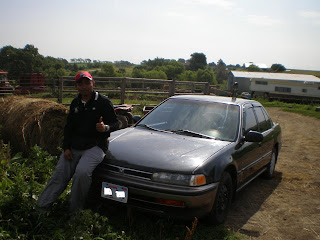
Termites or white ants, in some countries, were from the Order Isoptera. Culliney & Grace (2000) reported that there are more than 2700 species of isopteran in the world. In Peninsular Malaysia alone, there are about 175 species of termite from 42 genera (Tho, 1992). Termites can be classified under three main groups; dampwood termites, drywood termites and subterranean termites. The most destructive is subterranean termites and termite control is generally focused only on to this group (Abdul Hafiz & Mohd Hadzri, 2007).
 “Knowledge and understanding of subterranean termite foraging biology and ecology could help in their detection and control"
“Knowledge and understanding of subterranean termite foraging biology and ecology could help in their detection and control"In addition, subterranean termite is a cryptic insect. Knowledge and understanding of their biology, foraging area and the ecology help a lot in their detection and control. Thus the right choice of type of termiticide and the proper way in termiticide application technique are important to ensure the job efficacy. Recently, some of the pest control company proposing to their client a minimum internal drilling liquid termiticide application method. As we all have been told that traditional application technology associated with soil barrier treatment is destructive to property owners and needs the use of a high amount of finished product because it specifies a thorough and uniform application to the interior and exterior of the building by drilling holes through the slab near to the beam foundation (Potter and Hillery, 2003; Hu and Hickman 2006; Abdul Hafiz & Abu Hassan, 2006; Abdul Hafiz et al, 2006; Abdul Hafiz et al, 2007).

According to Potter and Hillery (2003), it is believed that the application of repellent termiticide can be more destructive to property due to the traditional application method. With the new non-repellent termiticide in the market, the termiticide can be applied as minimum as possible solely around the exterior building perimeter plus limited interior, especially at the termite infestation area. The method is practice by some of the pest control due to the unique character of the termiticide. The delayed mode of action permits transfer of this toxicant from exposed termites to unexposed nest mates through social interactions including mutual grooming, thus causing secondary mortality in subterranean termite population (Potter & Hillery 2003; Hu & Hickman, 2006; Gurbel et al, (2006); Abdul Hafiz et al, 2007a,b).
Preparing the termiticide solution
“Termiticide advantages of the unique character of its delayed mode of action”
Recently, the termite control team from School Of Biological Sciences, USM had conducted a field trial with the new non-repellent termiticide, Premise 200SC. The study showed a very promising results, where all the structures were treated as minimum interior drilling as possible showed full control of the foraging population inside the structure within 3 months (Abdul Hafiz et al, 2007a,b). However, to apply this method, termite foraging study need to be conducted to determine the foraging territory, population size and the numbers of the termite colony infested the building. In addition, this study also showed that placement of the termiticide directly in the vicinity of an entry point of foraging termites was the most important determinant for full control of termites.
As a conclusion from this study demonstrates that the minimum internal drilling method will minimizing the termiticide usage, less number of holes on the floor, less chemical & labor cost and more time saving. More important is less chemical into the environment but still provide effective and longer protection where it is a good option to pest control. Nevertheless, in termite control, IPM program is a must such as moisture management, inspection, monitoring, education, and collaboration of all termite-affected parties.
 Reference
Reference
Abdul Hafiz, A.M & A. Abu Hassan (2006). Transfer effect of Premise 200SC containing imidacloprid on subterranean termites population (Coptotermes gestroi) (Isoptera:Rhinotermitidae). , pp. 55. Proceedings, 1st USM-Penang International Postgraduate Convention, 3rd Life Sciences Postgraduate Conference, 24-27 May 2006, Universiti Sains Malaysia,Penang, Malaysia (abstract only).
Abdul Hafiz, A.M , Abu Hassan Ahmad, M.Z.A, Abdul Rashid (2006). Field Efficacy of Premise 200SC Against Coptotermes gestroi (ISOPTERA: RHINOTERMITIDAE) and Globitermes sulphureus (ISOPTERA:TERMITIDAE) in Seberang Perai and Balik Pulau, Penang, Malaysia. pp., 82. Proceedings,The 11th Biological Sciences Graduate Congress,Bangkok, Thailand. December 15-17, 2006
Abdul Hafiz, A.M & A. Mohd Hadzri (2007). Kaedah penyampelan, pemerangkapan dan pemantauan anai-anai di lapangan., pp. 118-125. Prosiding, Seminar Kebangsaan Teknologi Makmal Ke-8, 25-26 April 2007, Universiti Malaysia Sabah.
Abdul Hafiz, A.M , Abu Hassan Ahmad, M.Z.A. Rashid & Salah Salem Gurbel, (2007a), Minimum Interior Treatments Of Imidacloprid On Subterranean Termite Control., pp. 56, Proceedings, 9th Symposium of Malaysian Society of Applied Biology, Bayview Hotel, Georgetown, Penang, Malaysia. May 30th – 31st 2007.
Abdul Hafiz, A.M, A. Abu Hassan, Rashid M.Z.A. (2007b). Field Efficacy Of Imidacloprid On Subterranean Termite (Globitermes sulphureus), (Isoptera:Termitidae) in Penang_ Short Communication J.Bioscience, 18(2), 25 –30, 2007- in press
Culliney, T.W. & Grace, J.K. (2000). Prospects for the biological control of subterranean termites (Isoptera: Rhinotermitidae), with special reference to Coptotermes formosanus. Bulletin ofEntomological Research No. 90, 9 – 21 (Review article).
Potter, M.F and A.E Hillery. 2003. Trench warfare.
Pest Control Technology 31(2):28-32,57,58




















